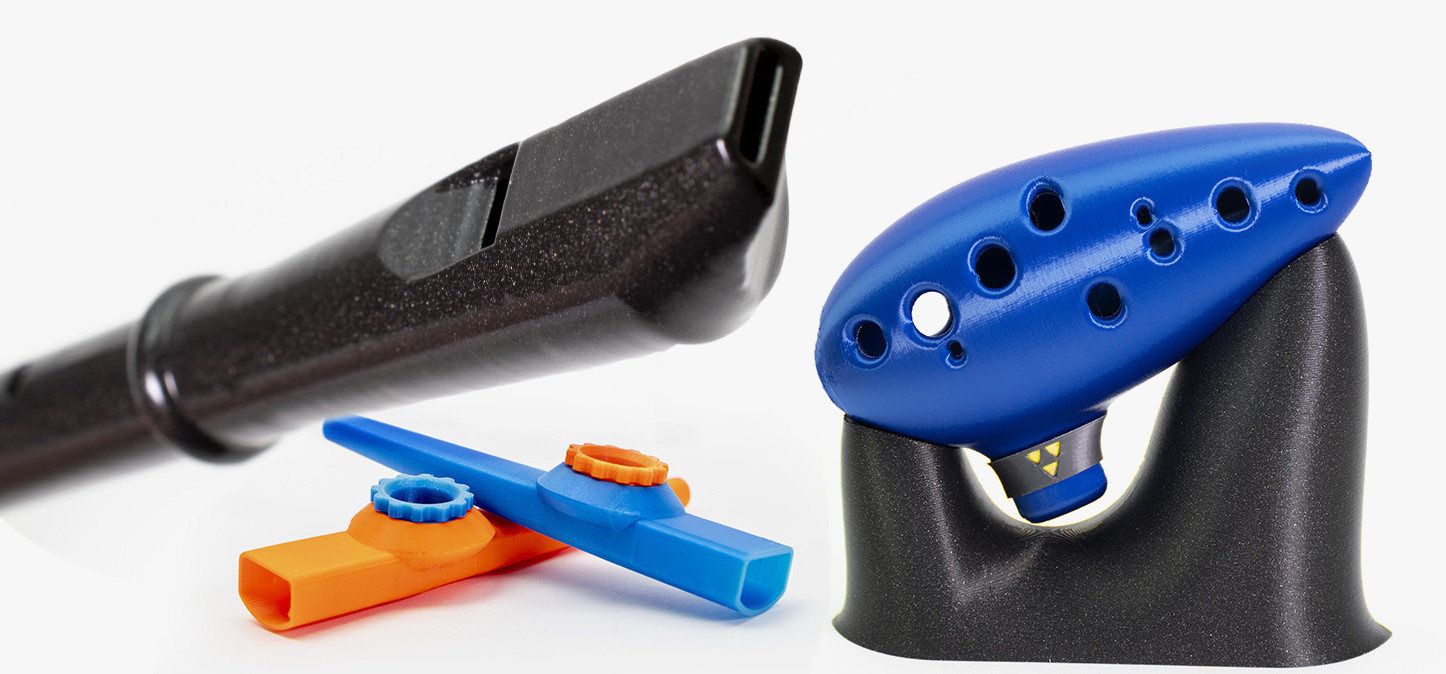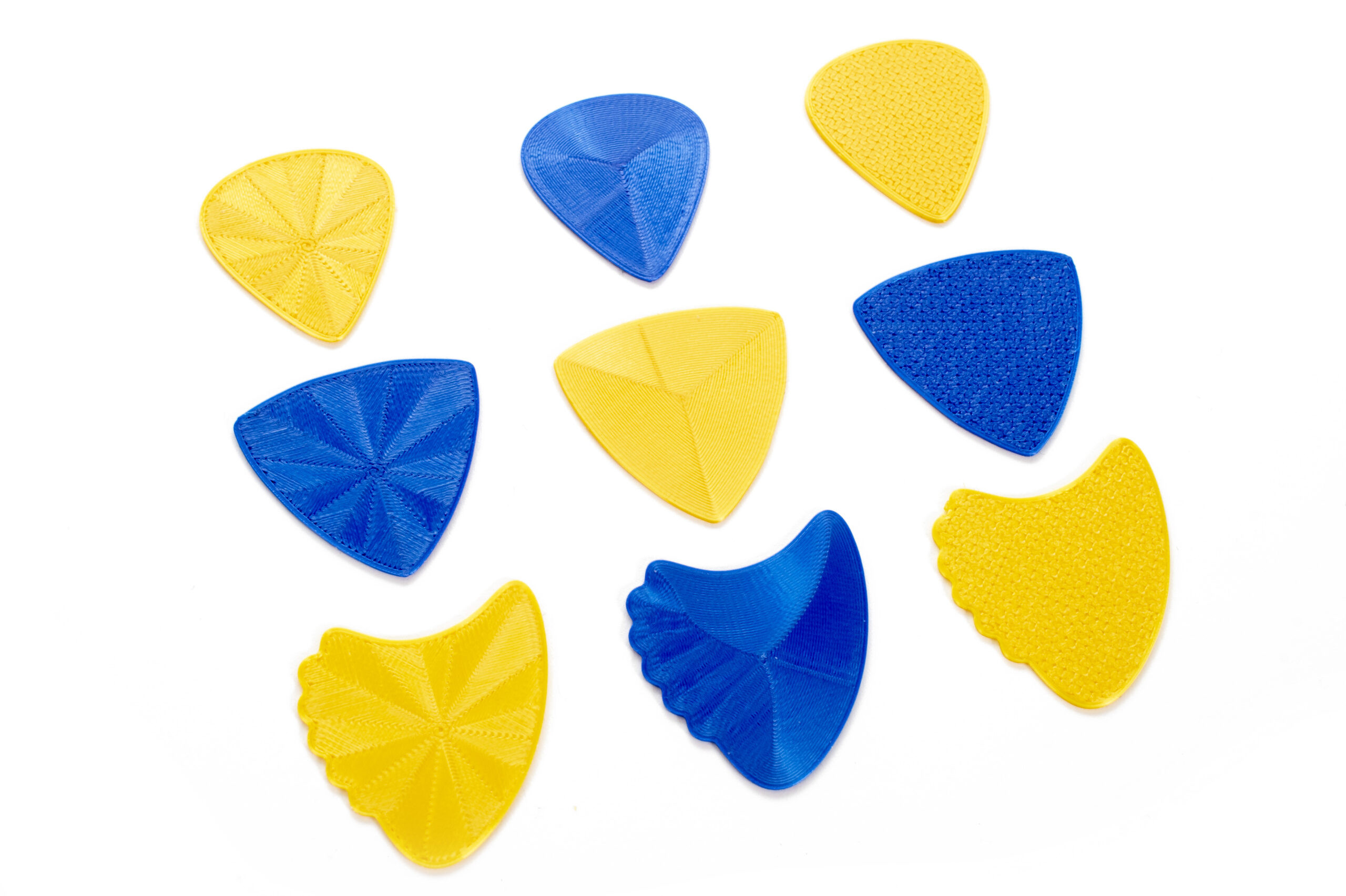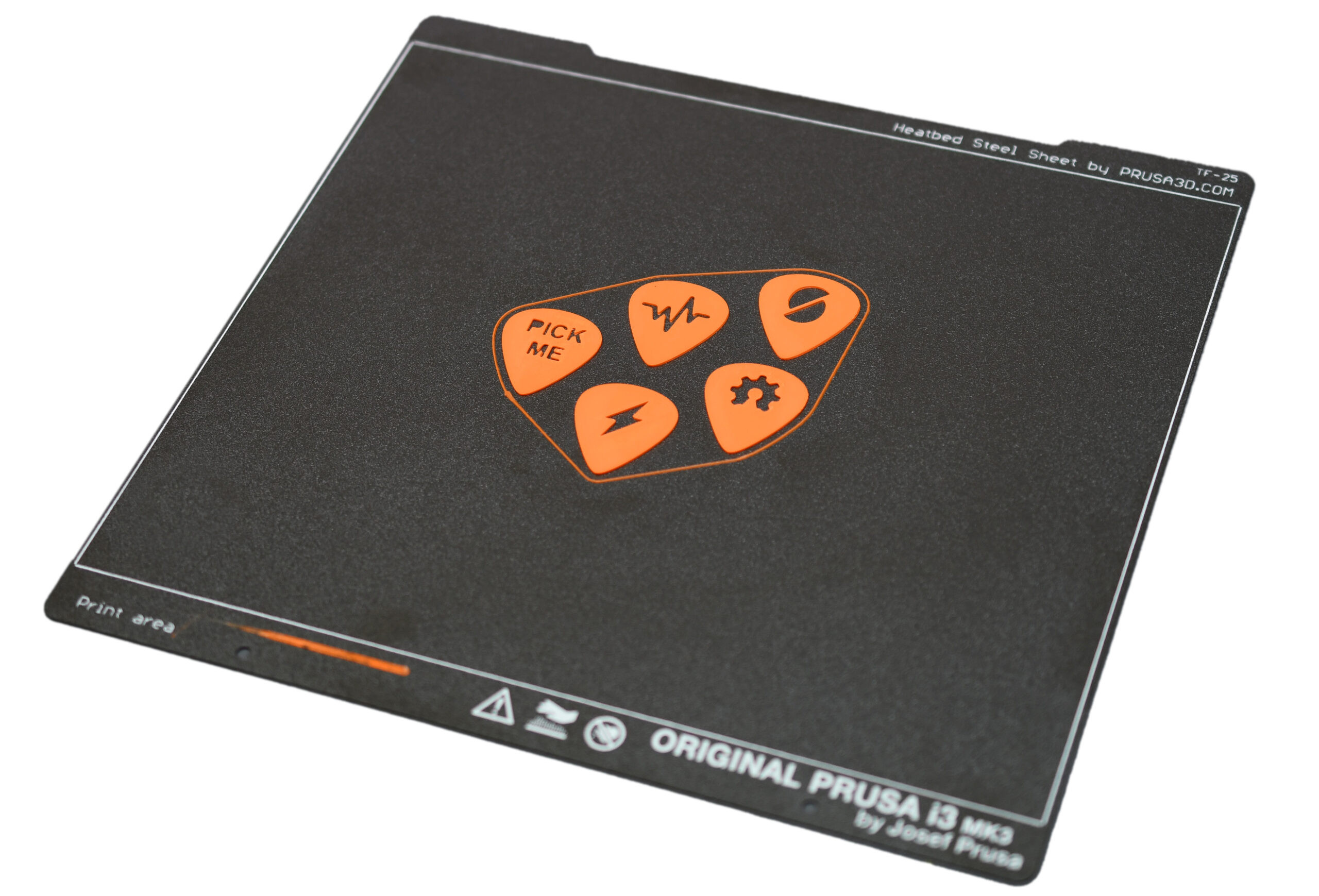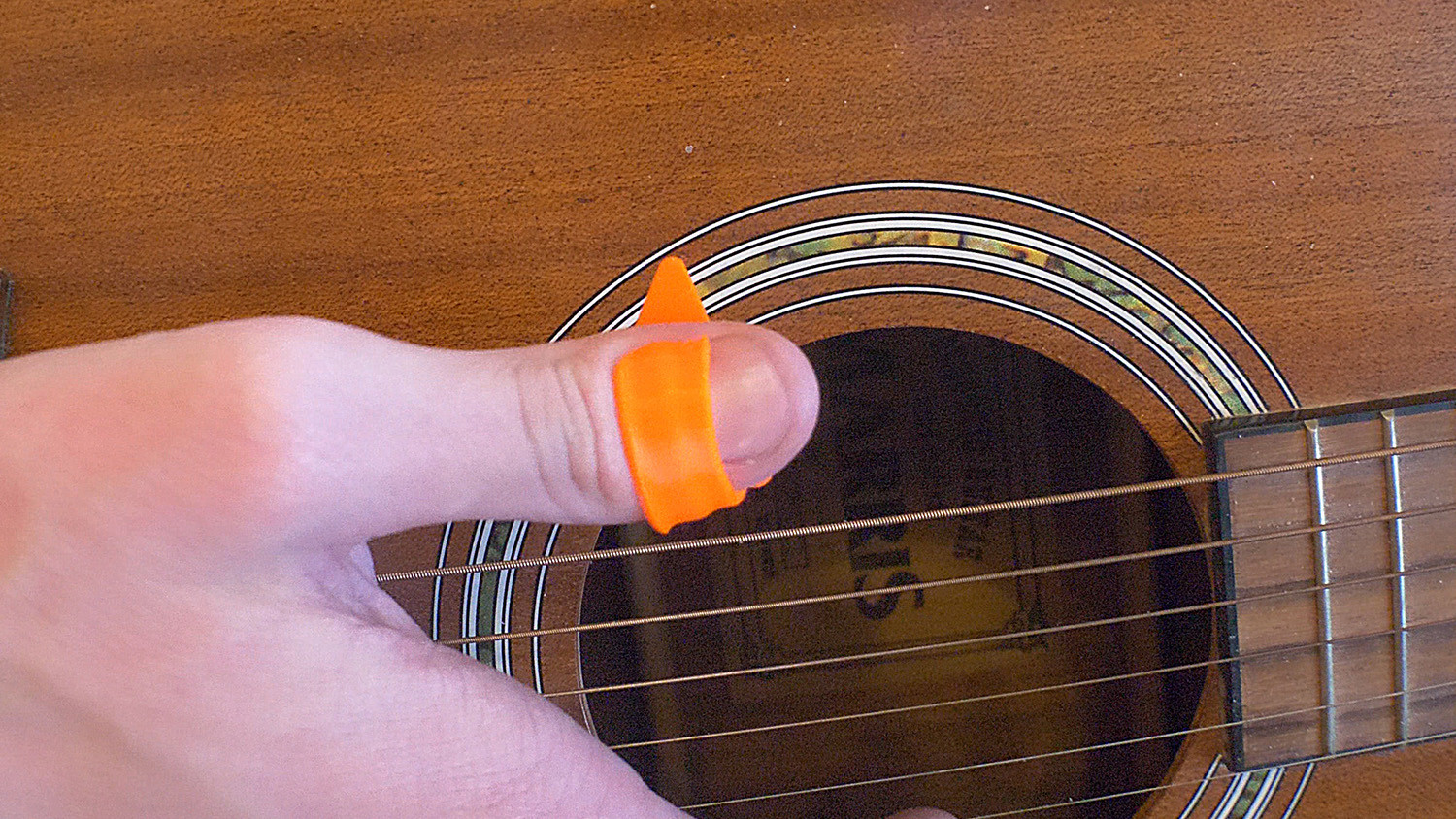Like many guitarists, I’ve amassed a collection of guitar picks over the years, yet they always seem to vanish right when I need them most. The other day, in a desperate search before a practice session, I found myself empty-handed after a 20-minute hunt through guitar cases, under amps, and even inside my acoustic guitar! The thought of 3D printing a guitar pick crossed my mind, but skepticism quickly followed – could a printed pick actually be any good? Driven by necessity, I downloaded a 3D model, hit print on my MINI, and within minutes, I had a playable guitar pick in my hand. To my surprise, it wasn’t just a makeshift solution; it felt and played just like any store-bought pick. Printed in standard PLA, this small, rapid print proved to be incredibly useful, sparking a wave of questions about Customized Guitar Picks.
This experience opened up a world of possibilities. What if I could tailor every aspect of my guitar pick to perfectly match my playing style and tone? What thickness truly suits my strumming and lead work? Are there shapes beyond the standard that could enhance my technique? And what materials could unlock new sonic textures? Let’s dive into the world of customized guitar picks and explore how you can create your own perfect plectrums.
Dialing in Your Ideal Thickness for Customized Guitar Picks
The thickness of a guitar pick is a crucial factor in its feel and sound, with even fractions of a millimeter making a noticeable difference. Generally, thinner picks (0.4 – 0.6 mm) are favored for acoustic strumming, offering greater flexibility and a softer attack. Conversely, thicker picks (0.8 – 1.2 mm) provide a brighter, more articulate sound ideal for lead guitar work and solos, delivering precision and power. Many guitarists, especially beginners, find a comfortable middle ground with versatile 0.6 – 0.8 mm picks.
While variety packs offer an assortment of thicknesses, you often end up with a surplus of unwanted picks and only a few favorites. 3D printing customized guitar picks eliminates this waste. By simply rescaling the pick model in your slicer software, you can effortlessly generate picks of any thickness. Experiment with a range of thicknesses, identify your sweet spot, and then print as many as you need. In PrusaSlicer, remember to create actual copies (Ctrl+C, Ctrl+V) rather than instances (+ key) to independently adjust the scale of each pick. To input precise thickness values, unlock the uniform scaling by clicking the lock icon in the right panel, allowing you to edit the Z-axis height directly.
Consider your layer height when aiming for specific thicknesses. A 0.7 mm pick printed with a 0.2 mm layer height will be rounded up to 0.8 mm. PrusaSlicer conveniently displays the actual printed height next to the slider in the preview, enabling you to fine-tune your layer height for accuracy.
 Close-up of a hand adjusting the Z-axis height of a guitar pick model in PrusaSlicer software, highlighting the customization of thickness for 3D printed guitar picks.
Close-up of a hand adjusting the Z-axis height of a guitar pick model in PrusaSlicer software, highlighting the customization of thickness for 3D printed guitar picks.
Unleash Creativity with Shapes, Textures, and Colors for Personalized Guitar Picks
Beyond thickness, the shape of your guitar pick significantly impacts your playing experience. While the classic teardrop shape is ubiquitous, exploring other shapes can unlock new techniques and tones. Jazz picks, known for their pointed tip and smaller size, excel in fast, articulate picking. Tri-tip picks offer a broader grip and three playing edges, extending pick life and offering tonal variations. Sharkfin picks, famously used by The Beatles, feature a unique shape with distinct sounds depending on the edge used, and their curved design allows for quick transitions between pick and fingerstyle playing. I’ve digitally recreated these diverse shapes in Fusion 360, and you can download them ready for 3D printing from PrusaPrinters.org.
But why stop at existing shapes? The beauty of customized guitar picks lies in limitless creativity. Want a pick shaped like the Pick of Destiny from the Tenacious D movie? Go for it! I sculpted my own Pick of Destiny replica in Blender, using PrusaSlicer’s color change feature to achieve the movie-accurate look with Prusament PLA Galaxy Black, Lime Green, and Mystic Green. You can find this design on PrusaPrinters.org as well.
 A vibrant, multi-colored 3D printed replica of the "Pick of Destiny" guitar pick, showcasing the detailed customization possible with 3D printed guitar picks.
A vibrant, multi-colored 3D printed replica of the "Pick of Destiny" guitar pick, showcasing the detailed customization possible with 3D printed guitar picks.
Color is another easily customizable guitar pick feature. Match your pick to your guitar’s finish, your band’s color scheme, or simply your favorite hue. For a personalized touch, consider adding textures. Emboss simple patterns, your band’s name, or even a simplified logo for enhanced grip and visual appeal. Use color changes to make these details pop, or subtract shapes to create unique镂空 designs.
 A collection of 3D printed guitar picks in various colors, including one perfectly matching a red Fender guitar, illustrating the color customization aspect of 3D printed guitar picks.
A collection of 3D printed guitar picks in various colors, including one perfectly matching a red Fender guitar, illustrating the color customization aspect of 3D printed guitar picks.
With such unique and personalized customized guitar picks, they become fantastic, inexpensive merchandise for gigs. I now carry a handful of 3D printed picks in my wallet, ready to share. They’re always a conversation starter, and fellow guitarists are thrilled to receive such a personalized and practical gift.
Exploring Infill Patterns for Unique Textures in Customized Guitar Picks
Even infill patterns, typically hidden inside 3D prints, can contribute to the unique aesthetic of customized guitar picks. While monotonic infill creates simple angled lines, experimenting with patterns like Octagram Spiral, Hilbert Curve, and Concentric infill, especially with shiny filaments, yields visually striking results.
 Three 3D printed guitar picks displaying different infill patterns: Octogram Spiral, Concentric, and Hilbert Curve, highlighting the textural customization achievable through infill in 3D printed guitar picks.
Three 3D printed guitar picks displaying different infill patterns: Octogram Spiral, Concentric, and Hilbert Curve, highlighting the textural customization achievable through infill in 3D printed guitar picks.
For infill patterns that remain consistent across layers (like Concentric), incorporating at least one rectilinear infill layer in the pick’s core is recommended. This strengthens the pick against breakage along extrusion lines, enhancing durability.
Adding Practical Features: Keyring Holes and Tuner Peg Holders to Customized Guitar Picks
Having a backup pick readily available is always a smart move. By adding a small hole to the grip of your customized guitar pick, you can easily attach it to your keyring, ensuring you’re never without one. For added convenience, size the hole to match the diameter of your tuner peg (typically 6mm). This allows you to store a pick directly on your guitar’s tuner, eliminating the need for adhesive pick holders. You can incorporate the hole directly into your pick design in CAD software. However, PrusaSlicer offers a more versatile approach using Modifiers. This allows you to add holes to downloaded designs without altering the original model, avoiding the need for separate versions.
 A close-up of a 3D printed guitar pick with a hole added for keyring attachment and tuner peg storage, demonstrating the practical customization of 3D printed guitar picks.
A close-up of a 3D printed guitar pick with a hole added for keyring attachment and tuner peg storage, demonstrating the practical customization of 3D printed guitar picks.
PrusaSlicer’s Modifier feature also enables adding band logos or names to your customized guitar picks. Simply extrude an SVG file of your logo or text to create a modifier shape. Numerous logos and basic shapes are available in SVG format on platforms like flaticon, making personalization easy.
 A collection of 3D printed guitar picks customized with various stencil designs and logos, showcasing the logo and stencil customization options for 3D printed guitar picks.
A collection of 3D printed guitar picks customized with various stencil designs and logos, showcasing the logo and stencil customization options for 3D printed guitar picks.
Thumbpicks: Expanding Your Playing Style with Customized Guitar Picks
For blues and jazz guitarists who incorporate basslines into their playing, thumbpicks are a valuable tool. While they may feel unusual initially, thumbpicks enhance the clarity of bass notes and open up a unique playing style. A snug fit is essential for thumbpicks to prevent slipping. 3D printing customized guitar picks makes it easy to experiment with different sizes to find your perfect fit. Thumbpick models are also available on PrusaPrinters.
 A 3D printed thumbpick, illustrating the specialized shapes and customization available through 3D printed guitar picks.
A 3D printed thumbpick, illustrating the specialized shapes and customization available through 3D printed guitar picks.
Material Matters: Durability and Tone of Customized Guitar Picks
After months of using 3D printed picks, their durability has impressed me. It took significant force on an acoustic guitar to finally break a 0.5mm thin PLA pick – and even then, thicker picks remain virtually indestructible regardless of material.
The primary difference between materials lies in stiffness. PLA picks feel similar to slightly thicker PETG or ASA picks. Prusament PC Blend creates exceptionally durable picks with medium flexibility. However, for customized guitar picks, there’s no need to buy specialized filament. Use whatever you have on hand; even small sample spools will yield dozens of picks.
Optimizing Print Orientation and Perimeters for Durable Customized Guitar Picks
Using at least the default setting of 2 perimeters is crucial for preventing edge tearing in customized guitar picks. For advanced users, PrusaSlicer’s seam painting feature allows you to ensure a continuous perimeter loop in the string contact area. The edge of the first perimeter naturally smooths out with use.
While complex bottom-side designs or vertical printing might seem appealing, printing picks flat on the print bed is optimal. This simplifies printing and maximizes durability, as the flat orientation minimizes layer separation risks under playing pressure.
Final Pick: Embrace Customized Guitar Picks
Once you’ve dialed in your preferred pick thickness, shape, and features, 3D printing empowers you to create an endless supply of customized guitar picks. You’ll always have the perfect pick at your fingertips and a unique, inexpensive giveaway for fellow musicians. So, rock on and happy printing your own customized guitar picks!

